Introduction: The Options Trading Landscape
Welcome, Chart Guys members, and thank you for joining us to peel back the layers of options trading. This resource is crafted for those embarking on their journey into the options universe—whether you're just starting to explore or gearing up to dive in soon. Options trading can be your tool for potential high rewards, but remember, with these rewards come significant risks.
First Steps in Options Trading
Before we wade into the deeper waters of options, let's establish the groundwork. Options trading isn't just for those with substantial capital. Even with a modest amount, say $5,000, steering clear of the siren song of penny stocks and focusing on options can build a substantial portfolio. It's about education and strategy over chance.
The Essence of Options
What exactly is an option? It's an agreement where the buyer pays the seller for the right, but not the obligation, to buy or sell a stock at a specified price before the option expires. Consider it a premium, much like an insurance policy, where you're securing a future opportunity. This premium can be 'flipped' for profit without ever needing to exercise the option itself.
Developing a Tactical Approach
As with any form of trading, diving into options without preparation is akin to gambling. It's not advisable to play poker without knowing the rules, much less with your hard-earned money at stake. This was a lesson learned the hard way, as I personally lost a significant sum when I first jumped into options without adequate preparation.
The Dynamics of Options Trading
Understanding the mechanics—buy to open, sell to close, calls, puts, and the significance of the strike price—is fundamental. Options can be a fit for cash accounts, which means lower capital requirements and an escape from the restrictions of pattern day trading rules, opening up opportunities to trade on the big names in the stock market.
Risk Management and Strategies
Risk management is key. You can't lose more than you put in, which is a protection in itself. Yet, worst-case scenarios like losing the entire investment are also a reality. This is where strategies such as setting stop losses and choosing the right strike price, based on whether it's in the money or out of the money, come into play.
The Greeks and Market Indicators
The Greeks—Delta, Gamma, Theta, Vega, and Rho—sound like a foreign language to the uninitiated but are critical to understanding the subtleties of option pricing. Theta, or time decay, is particularly noteworthy, as it measures how the price of an option decreases over time.
Real-World Trading Examples
Through practical examples, you'll see the potential of options. A trade on the SPY, the S&P 500 ETF, can illustrate the rapid gains possible, where a well-placed put option could turn a $1,200 investment into a $2,400 profit in just half an hour. But it's not without risk—the possibility of an equivalent loss is just as real.
Continual Learning and Community Engagement
In options trading, education is an ongoing process. While this guide provides a solid foundation, engaging with a community of traders can offer real-time insights and strategies. Whether it's following unusual options activity or sharing experiences, learning from each other is a powerful tool.
Disclaimer: This video transcript summary has been created or edited with the help of various AI tools.
















